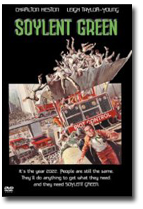Movies |
Soylent Green
directed by Richard Fleischer
By
Published: Jan 01, 2006
Category:
Drama
Soylent Green
directed by Richard Fleischer
When Charlton Heston reveals the movie’s by-then obvious secret with the line “Soylent Green is…people,” you have a choice. You could think, “This is ludicrous. I’m watching a cult classic.”
Or you could think, “Who’d have thought anyone would make such a dark, scary movie about the environment in 1973?”
For the past few decades, “cult classic” — indeed, “camp classic” — has been the common opinion.
With good reason. When he made “Soylent Green,” Heston was at the point in his career when he was appearing in pap like “Beneath the Planet of the Apes” and heading toward “Airport 1975.” And Richard Fleischer — whose past credits as a director included “20,000 Leagues Under the Sea” and “Fantastic Voyage” — was moving quickly into shlock like “Mandingo” and “Amityville 3-D.”
But when you check your attitude at the door, you find much less to mock in “Soylent Green” — and a lot to admire.
For those who haven’t had the pleasure, “Soylent Green” is a sci-fi film set 50 years ahead of its creation — in far-distant 2022. Concerns about population growth have been ignored; there are now 40 million people in New York alone. And, as you’d expect, they’re breathing foul air and living in sadly faded apartments. Unemployment is rampant. So is hunger.
State-sponsored euthanasia is one solution. Another is artificial food. (“Soylent” is a combination of two cheap, easy-to-grow foodstuffs, soy and lentils.) Making the connection is the climax of the film. And therein lies its power.
For one thing, the key to Heston’s discovery is his co-star, Edward G. Robinson. He’s old and tired; he’s had enough of life. And so he’s decided to be euthanized. It’s quite the lovely experience, for you get to watch a video of beautiful, bucolic imagery as you await the procedure. Blue skies, green forests — everything that’s been lost is here to watch. And the music is Beethoven’s Sixth Symphony. [Movia trivia: Heston shed real tears in this scene, for he know what few did — Robinson was dying of cancer and this would be his last film.]
Heston’s reaction is the film’s second great strength. In 1973, Heston was still an action hero, a kind of Schwarzenegger or Willis. And in this action-man role, he races to the factory. He sees bodies going in and crackers coming out. And, in a desperate effort to share the news before he’s killed, he rushes through the streets, delivering his now-legendary warning.
Until these scenes, we’ve been shown a standard-issue dystopia. Scarcity for the many poor, luxury for the few rich. Beautiful women as playthings. Primitive video games for entertainment. For the horror of it, machines scooping up bodies. And, in a bad rewriting of the scene in which Winston Smith remembers the smell of real coffee in George Orwell’s “1984,” we have Edward G. Robinson recalling the taste of real food.
But these final scenes take the film to another level. A.H, Weiler, writing in The New York Times, did not see that. "’Soylent Green’ projects essentially simple, muscular melodrama a good deal more effectively than it does the potential of man’s seemingly witless destruction of the earth’s resources,” he wrote. “This 21st-century New York occasionally is frightening but it is rarely convincingly real.”
That review was written when the movie was released. “Global warming” was a new phrase. Al Gore was 25. Now that almost everyone fears global warming and Gore is pushing 60, “Soylent Green” is a different movie. A cult classic — not a camp one.
To buy "Soylent Green" — for $7.47 — from Amazon.com, click here.


